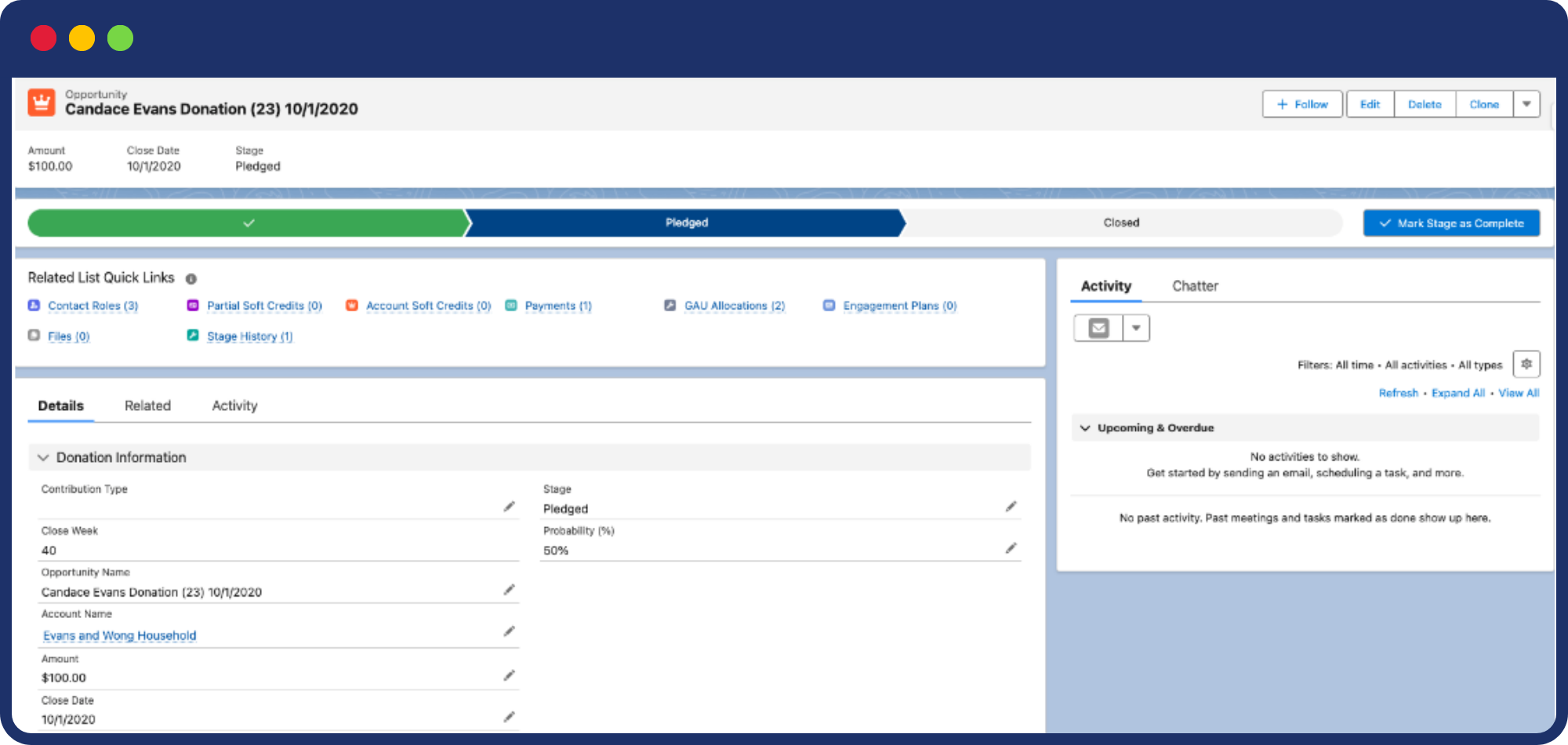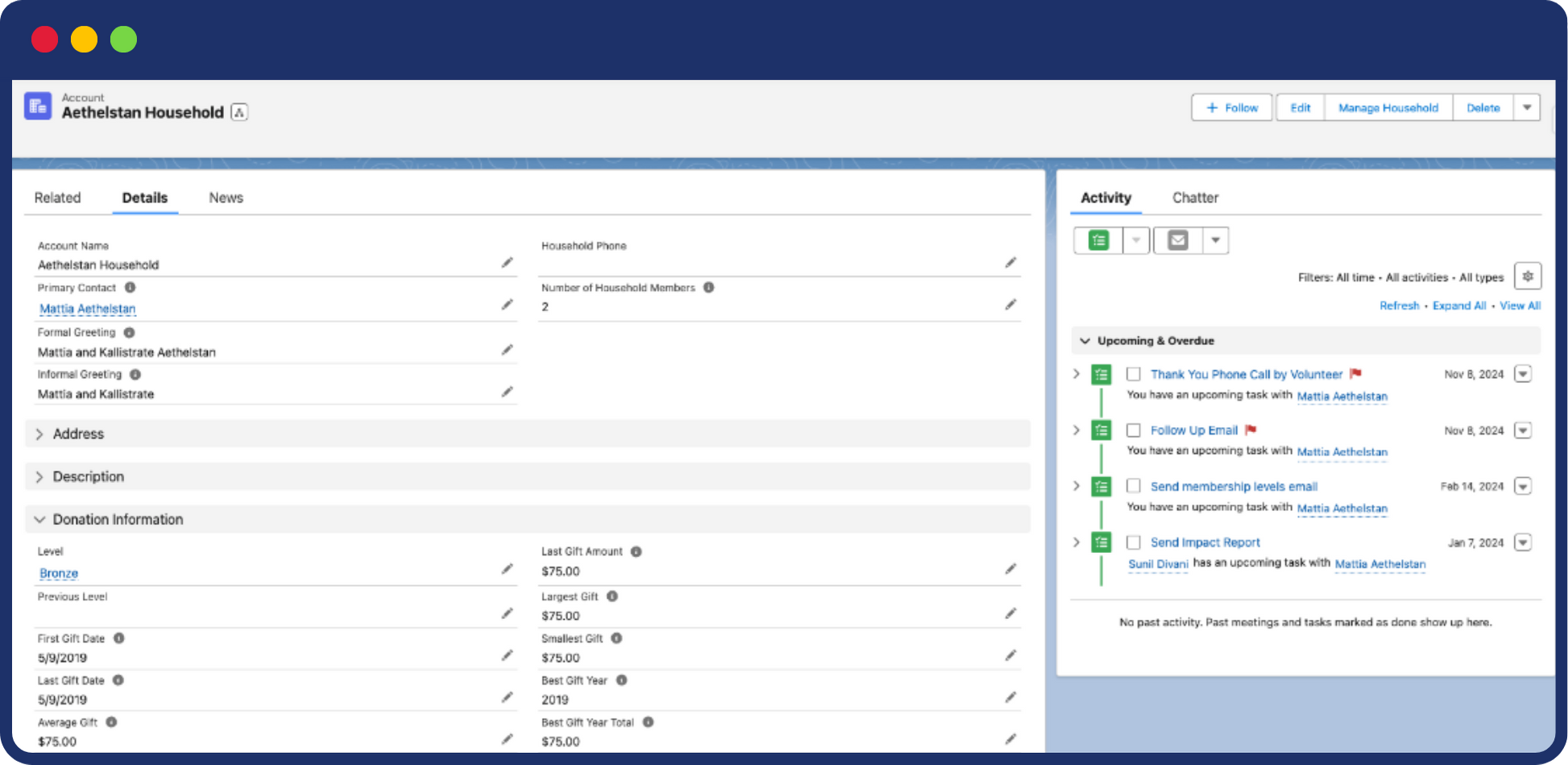
Rosetta Stone for Migrating to Salesforce from Raiser’s Edge: Understanding Gifts and Attributes
In part one of our Migrating to Salesforce from Raiser’s Edge series, we discussed how to track your fundraising outreach efforts in Salesforce, as compared to Raiser’s Edge.
Now, let’s take a look at tracking your incoming gifts and attributes. (Spoiler – Salesforce makes it all very simple!)
Gifts are, of course, critical to the nonprofit funding model in general. So, it is no great insight to say that gifts need to be tracked, for accounting reasons, if nothing else. But, tracking your entire gift pipeline (from planning a solicitation to check in hand) can make a huge difference in fundraisers’ ability to prioritize their work, in finance’s ability to forecast revenue, and leadership’s ability to make informed decisions. The more nuance you can capture in that pipeline, the more impactful the tracking can be.
Attributes are often one of the ways that nuance and detail around a gift, person, organization, etc., get tracked. Different systems have different names for this kind of information—the kind of detail that needs to also be seen in the big picture. Knowing that a given donor is a volunteer for your organization is important both when interacting with that donor, but also when trying to understand your donor base and your volunteer base. Having the ability to capture these kinds of details in a structured, reportable format opens new ways to analyze your data and therefore new insights into your constituents and donors and their behavior.
Attain Partners expertly helps fundraising teams move from Raiser’s Edge (with or without NXT) to Salesforce for greater functionality and scalability. With that move comes not only a host of new information and tracking superpowers but also a new language and way of organizing information. This primer series for fundraisers currently using Raiser’s Edge was created to help you and your team learn the language of Salesforce and some of its organizing principles. If you missed part one, learn more about Campaigns, Funds, and Appeals.
Gifts and Attributes
Gifts
Raiser’s Edge terms: Gifts
Salesforce translation: Opportunities and Gift Entry
In Raiser’s Edge, you may be used to entering gifts as Gifts either right from a constituent’s record or on its own. For recurring gifts, you choose “Recurring Gift” as the type, and for pledges, you choose “Pledge.” In Salesforce, the workflow is similar, but the main hub is called an Opportunity.


In Salesforce, Opportunities represent opportunities for money. An Opportunity could be a gift that you’re soliciting or a grant you’re applying for. They are connected to Contacts (i.e., constituents) and Accounts (e.g., households, organizations, companies) in a way that allow you to easily see automatically calculated things like last gift amount, total giving, largest gift amount, etc., at both the individual and household or company level.

Like a Gift in Raiser’s Edge, an Opportunity in Salesforce can have a series of payments associated with it, which can be either scheduled for the future or tracked for the past. Payments can be either automatically or manually generated for recurring gifts or pledges and easily marked as paid when payment is received.
Opportunities can be attributed to a Campaign to track the success of your appeals and automatically add appropriate General Accounting Units to the gift. Opportunities have stages (which you will customize during implementation) where you can track progress toward an actual gift. Like in Raiser’s Edge, Opportunities in Salesforce have types, also customized during implementation, to represent the different kinds of gifts (pledge, recurring gift, grant, in-kind, etc.) that you receive. These types can control automated behavior as well as the layout of the page for each type of Opportunity record.
Opportunities are the core of how you report on giving and your fundraising pipeline in Salesforce. Stage and type are key to being able to report on your fundraising in a rich and varied way. Want to know how much you raised last quarter? Want to know how much you received in in-kind donations last year? Salesforce reports have pre-built filters and summary features that will answer those questions for you.
To ensure the accuracy of your reporting, even gifts that come in without solicitation will have an Opportunity record. Generally, you’d create an Opportunity and track its progress from cultivation through to actual gift. When you receive a gift without solicitation, you will either create an Opportunity and mark it as Closed-Won or system automation will do that for you if you add the gift through the batch entry tool. That way, the unsolicited gift will be included in your reporting and the automatically-calculated amounts along with the solicited gifts.
Attributes
Raiser’s Edge terms: Attributes
Salesforce translation: Custom fields

In Raiser’s Edge, it’s common to use Attributes to tag records in various ways so you can group them in lists and reports. Salesforce is a more structured database, so many things you may have added as Attributes aren’t necessary. Account type (Organization vs. Business vs. Household), for example, is reflected in the record type of the Account rather than requiring a special field to keep track of what kind of account it is. Similarly, the status of the address of a Contact is captured in the fields themselves (there are sets of fields to capture current and former addresses).
Your implementation partner will work with you to determine which of the Attributes you currently use need to be mapped onto new fields in Salesforce, which ones can be mapped onto standard Salesforce fields, and which can be derived from existing Salesforce information. Don’t have an implementation partner? Contact us to learn how we can help your organization move from Raiser’s Edge to Salesforce.
For the Attributes that need to be mapped onto new Salesforce fields, your implementation partner or Salesforce admin can add them easily and they will be available in reports by default. These fields can be available to only certain types of records and only visible to certain types of users, ensuring they don’t clutter the screen when they’re not needed. The difficult part of the process is not adding the fields, but deciding whether or not they should be added, how they will be used, and how to make sure that the data entered into them remains consistent and accurate.
To that end, Salesforce is designed to make maintaining the accuracy and consistency of your data easy. There are a wide range of things to consider when adding a field including the data type, where to make it visible and for whom, who to give edit access to, and more. With Salesforce, it is simple to ensure that only those people best positioned to consider all the implications of new fields and field types are empowered to create them. Taking these steps to keep your data consistent and accurate allows you to take advantage of the full power of the Salesforce reporting and analytics platform, so that your data can become useful information.
Want to learn about tracking fundraiser portfolios, moves management, and extending functionality in Salesforce?
Send us a message to schedule a time to chat with our experts.
Attain Partners – Salesforce Experts
No matter if your organization is beginning its Salesforce journey or 10+ years into development, Attain Partners is here to help you achieve your digital transformation goals.
To learn more, check out our Salesforce Innovation services, read case studies about our work, and explore blog posts from Attain Partners’ Salesforce team.
About the Author

Jaemi Loeb is a Senior Consultant at Attain Partners and a veteran nonprofit leader. Her expertise sits at the intersection between technology and people, tools, and daily operations. She is passionate about helping organizations to streamline their workflows and use data to meet their missions.

Be the First to Know
Subscribe to our monthly Pulse newsletter
to be the first to hear about new blog posts













